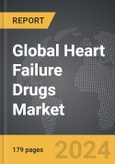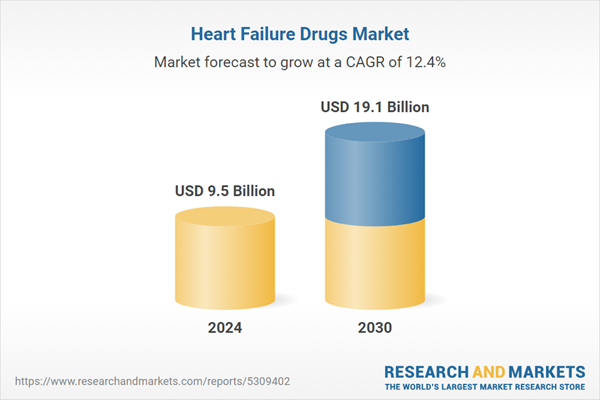The global market for Heart Failure Drugs was valued at US$9.5 Billion in 2024 and is projected to reach US$19.1 Billion by 2030, growing at a CAGR of 12.4% over the analysis period 2024-2030. This comprehensive report provides an in-depth analysis of market trends, drivers, and forecasts, helping you make informed business decisions. The report includes the most recent global tariff developments and how they impact the Heart Failure Drugs market.
Segments: Segment (Heart Failure Drugs).
Geographic Regions/Countries: World; United States; Canada; Japan; China; Europe (France; Germany; Italy; United Kingdom; Spain; Russia; and Rest of Europe); Asia-Pacific (Australia; India; South Korea; and Rest of Asia-Pacific); Latin America (Argentina; Brazil; Mexico; and Rest of Latin America); Middle East (Iran; Israel; Saudi Arabia; United Arab Emirates; and Rest of Middle East); and Africa.
The analysts continuously track trade developments worldwide, drawing insights from leading global economists and over 200 industry and policy institutions, including think tanks, trade organizations, and national economic advisory bodies. This intelligence is integrated into forecasting models to provide timely, data-driven analysis of emerging risks and opportunities.
Global Heart Failure Drugs Market - Key Trends and Drivers Summarized
Why Are Heart Failure Drugs Critical in Managing This Widespread Condition?
Heart failure drugs play a pivotal role in managing a condition that affects millions worldwide, helping to reduce symptoms, improve quality of life, and prolong survival. Heart failure, a chronic condition where the heart’s ability to pump blood is compromised, can lead to significant morbidity and mortality if not effectively managed. The primary goal of heart failure drugs is to alleviate the strain on the heart, improve blood flow, and prevent the worsening of the condition. Medications such as beta-blockers, angiotensin-converting enzyme (ACE) inhibitors, and diuretics are commonly prescribed to manage heart failure by reducing blood pressure, regulating heart rhythms, and eliminating excess fluids that can build up due to poor circulation. Without these medications, patients face a higher risk of complications such as fluid retention, fatigue, and shortness of breath. In severe cases, unmanaged heart failure can result in hospitalizations or even sudden death. Therefore, the development and optimization of heart failure drugs are essential not only for symptom control but also for reducing hospital admissions and improving long-term survival outcomes.How Do Different Classes of Heart Failure Drugs Work to Improve Patient Outcomes?
There are several classes of drugs that are central to heart failure management, each addressing different aspects of the disease. ACE inhibitors and angiotensin II receptor blockers (ARBs) are often first-line therapies. They work by relaxing blood vessels and reducing the workload on the heart, which lowers blood pressure and improves blood flow. Beta-blockers are another essential class of drugs that reduce heart rate and decrease the force of contraction, allowing the heart to work more efficiently and recover from strain over time. For patients who retain excess fluids, diuretics, commonly known as water pills, help to remove this excess fluid from the body, reducing swelling and improving breathing by lowering fluid buildup in the lungs. Additionally, newer drug classes like angiotensin receptor-neprilysin inhibitors (ARNIs) have emerged as highly effective in improving heart function by reducing strain on the heart and preventing worsening of symptoms. These drugs, like sacubitril/valsartan, have shown significant improvements in survival rates and reduced hospitalizations in clinical trials. Another important class includes aldosterone antagonists, which block the harmful effects of excess aldosterone - a hormone that can exacerbate heart failure by promoting fluid retention and worsening cardiac function. By targeting different pathways involved in heart failure, these medications work synergistically to reduce symptoms, slow disease progression, and improve overall outcomes for patients.What Are the Latest Developments and Innovations in Heart Failure Drug Therapies?
The landscape of heart failure treatment is evolving, with several promising developments that offer hope for better management and outcomes. One of the most significant innovations in recent years is the use of sodium-glucose cotransporter-2 (SGLT2) inhibitors. Initially developed as a treatment for type 2 diabetes, these drugs, such as dapagliflozin and empagliflozin, have demonstrated impressive results in reducing the risk of hospitalization and death in heart failure patients, even those without diabetes. This class of drugs works by helping the kidneys remove excess glucose and sodium, which in turn reduces blood volume and pressure, easing the burden on the heart. Additionally, gene therapy is gaining attention as a potential future treatment for heart failure. Researchers are exploring how modifying certain genes could repair or regenerate damaged heart tissue, offering a long-term solution rather than just symptom management. Another exciting area of innovation is the development of novel biologics and cell-based therapies that could potentially reverse heart damage by promoting the regeneration of healthy heart tissue. Clinical trials are ongoing to test the efficacy of these advanced therapies, which could represent a significant breakthrough in how heart failure is treated in the coming decades. These developments, along with ongoing improvements in existing drug formulations, are continuously refining heart failure treatment strategies, offering patients more personalized and effective options.What Are the Key Growth Drivers in the Heart Failure Drugs Market?
The growth in the heart failure drugs market is driven by several factors directly related to advancements in medical science, shifting demographics, and changing patient needs. One of the most significant factors is the rising prevalence of heart failure, driven by an aging population and the increasing incidence of cardiovascular diseases such as hypertension, diabetes, and coronary artery disease, which are major risk factors for heart failure. As the global population ages and chronic conditions become more prevalent, the demand for effective heart failure treatments continues to rise. In addition, advances in drug discovery and pharmaceutical technology have led to the development of new, more effective medications like SGLT2 inhibitors and ARNIs, which are transforming the standard of care and expanding the market for heart failure drugs. Furthermore, there is a growing focus on improving quality of life for heart failure patients, particularly in advanced cases, where new drug therapies aim to reduce hospital readmissions and manage symptoms more effectively. Another key driver is the increasing awareness and early diagnosis of heart failure, facilitated by better diagnostic tools and screening programs, leading to earlier intervention and more sustained use of medications. Moreover, the pharmaceutical industry’s shift toward personalized medicine, where treatments are tailored to the individual patient based on genetic, clinical, and lifestyle factors, is also expanding the market. These personalized approaches enable more effective management of heart failure, further driving demand for innovative and targeted therapies. Finally, the significant investment in research and development by both public and private sectors ensures a continuous pipeline of new treatments, fueling the growth of the heart failure drugs market as new, more effective solutions are brought to market.Report Scope
The report analyzes the Heart Failure Drugs market, presented in terms of units. The analysis covers the key segments and geographic regions outlined below.Segments: Segment (Heart Failure Drugs).
Geographic Regions/Countries: World; United States; Canada; Japan; China; Europe (France; Germany; Italy; United Kingdom; Spain; Russia; and Rest of Europe); Asia-Pacific (Australia; India; South Korea; and Rest of Asia-Pacific); Latin America (Argentina; Brazil; Mexico; and Rest of Latin America); Middle East (Iran; Israel; Saudi Arabia; United Arab Emirates; and Rest of Middle East); and Africa.
Regional Analysis
Gain insights into the U.S. market, valued at $2.4 Billion in 2024, and China, forecasted to grow at an impressive 16.3% CAGR to reach $4.6 Billion by 2030. Discover growth trends in other key regions, including Japan, Canada, Germany, and the Asia-Pacific.Why You Should Buy This Report:
- Detailed Market Analysis: Access a thorough analysis of the Global Heart Failure Drugs Market, covering all major geographic regions and market segments.
- Competitive Insights: Get an overview of the competitive landscape, including the market presence of major players across different geographies.
- Future Trends and Drivers: Understand the key trends and drivers shaping the future of the Global Heart Failure Drugs Market.
- Actionable Insights: Benefit from actionable insights that can help you identify new revenue opportunities and make strategic business decisions.
Key Questions Answered:
- How is the Global Heart Failure Drugs Market expected to evolve by 2030?
- What are the main drivers and restraints affecting the market?
- Which market segments will grow the most over the forecast period?
- How will market shares for different regions and segments change by 2030?
- Who are the leading players in the market, and what are their prospects?
Report Features:
- Comprehensive Market Data: Independent analysis of annual sales and market forecasts in US$ Million from 2024 to 2030.
- In-Depth Regional Analysis: Detailed insights into key markets, including the U.S., China, Japan, Canada, Europe, Asia-Pacific, Latin America, Middle East, and Africa.
- Company Profiles: Coverage of players such as AstraZeneca PLC, Bayer AG, Boehringer Ingelheim (Canada) Ltd., Bristol-Myers Squibb Company, CRC Health and more.
- Complimentary Updates: Receive free report updates for one year to keep you informed of the latest market developments.
Some of the 11 companies featured in this Heart Failure Drugs market report include:
- AstraZeneca PLC
- Bayer AG
- Boehringer Ingelheim (Canada) Ltd.
- Bristol-Myers Squibb Company
- CRC Health
- Exelixis, Inc.
- GlaxoSmithKline plc
- Johnson & Johnson
- Lunan Pharmaceuticals Co. Ltd.
- Merck & Co., Inc.
- Mylan N.V.
- Novartis AG
- Pfizer, Inc.
- Sanofi S.A.
- Shanghai Haini Pharmaceutical Co., Ltd.
- Shanghai Xudong Haipu Pharmaceutical Co., Ltd.
- The National Council for Palliative Care
- Valeant Pharmaceuticals International, Inc.
Tariff Impact Analysis: Key Insights for 2025
Global tariff negotiations across 180+ countries are reshaping supply chains, costs, and competitiveness. This report reflects the latest developments as of April 2025 and incorporates forward-looking insights into the market outlook.The analysts continuously track trade developments worldwide, drawing insights from leading global economists and over 200 industry and policy institutions, including think tanks, trade organizations, and national economic advisory bodies. This intelligence is integrated into forecasting models to provide timely, data-driven analysis of emerging risks and opportunities.
What’s Included in This Edition:
- Tariff-adjusted market forecasts by region and segment
- Analysis of cost and supply chain implications by sourcing and trade exposure
- Strategic insights into geographic shifts
Buyers receive a free July 2025 update with:
- Finalized tariff impacts and new trade agreement effects
- Updated projections reflecting global sourcing and cost shifts
- Expanded country-specific coverage across the industry
Table of Contents
I. METHODOLOGYII. EXECUTIVE SUMMARY2. FOCUS ON SELECT PLAYERSIII. MARKET ANALYSISIV. COMPETITION
1. MARKET OVERVIEW
3. MARKET TRENDS & DRIVERS
4. GLOBAL MARKET PERSPECTIVE
UNITED STATES
CANADA
JAPAN
CHINA
EUROPE
FRANCE
GERMANY
ITALY
UNITED KINGDOM
SPAIN
RUSSIA
REST OF EUROPE
ASIA-PACIFIC
AUSTRALIA
INDIA
SOUTH KOREA
REST OF ASIA-PACIFIC
LATIN AMERICA
ARGENTINA
BRAZIL
MEXICO
REST OF LATIN AMERICA
MIDDLE EAST
IRAN
ISRAEL
SAUDI ARABIA
UNITED ARAB EMIRATES
REST OF MIDDLE EAST
AFRICA
Companies Mentioned (Partial List)
A selection of companies mentioned in this report includes, but is not limited to:
- AstraZeneca PLC
- Bayer AG
- Boehringer Ingelheim (Canada) Ltd.
- Bristol-Myers Squibb Company
- CRC Health
- Exelixis, Inc.
- GlaxoSmithKline plc
- Johnson & Johnson
- Lunan Pharmaceuticals Co. Ltd.
- Merck & Co., Inc.
- Mylan N.V.
- Novartis AG
- Pfizer, Inc.
- Sanofi S.A.
- Shanghai Haini Pharmaceutical Co., Ltd.
- Shanghai Xudong Haipu Pharmaceutical Co., Ltd.
- The National Council for Palliative Care
- Valeant Pharmaceuticals International, Inc.
Table Information
| Report Attribute | Details |
|---|---|
| No. of Pages | 179 |
| Published | April 2025 |
| Forecast Period | 2024 - 2030 |
| Estimated Market Value ( USD | $ 9.5 Billion |
| Forecasted Market Value ( USD | $ 19.1 Billion |
| Compound Annual Growth Rate | 12.4% |
| Regions Covered | Global |









